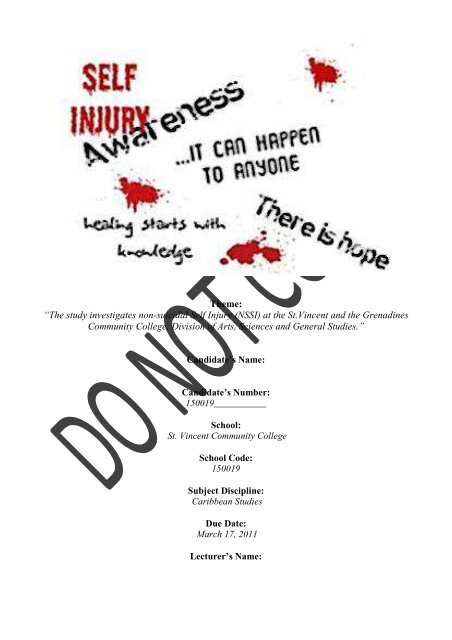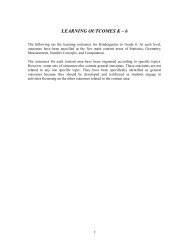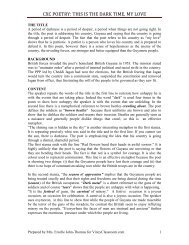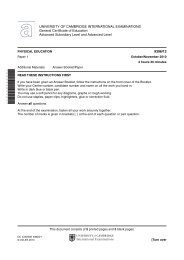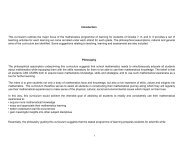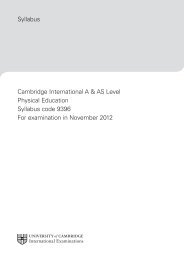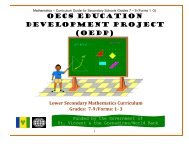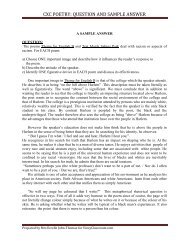Caribbean Studies Internal Assessment Example ... - VincyClassroom
Caribbean Studies Internal Assessment Example ... - VincyClassroom
Caribbean Studies Internal Assessment Example ... - VincyClassroom
You also want an ePaper? Increase the reach of your titles
YUMPU automatically turns print PDFs into web optimized ePapers that Google loves.
Theme:“The study investigates non-suicidal Self Injury (NSSI) at the St.Vincent and the GrenadinesCommunity College, Division of Arts, Sciences and General <strong>Studies</strong>.”Candidate’s Name:Candidate’s Number:150019___________School:St. Vincent Community CollegeSchool Code:150019Subject Discipline:<strong>Caribbean</strong> <strong>Studies</strong>Due Date:March 17, 2011Lecturer’s Name:
2ACKNOWLEDGMENTSFor the successful completion of this investigation, several persons must be dutifully thanked for theirsignificant contribution.First and foremost, The Lord, my Mighty Saviour is given all praise, for it is solely He who has madeanything possible.I am very grateful to Mr. G. Leacock, my <strong>Caribbean</strong> <strong>Studies</strong> Lecturer, for his weekly classes that werescheduled specifically for the teaching of the procedures and material required for this research project.I should also like to acknowledge Gian Thomas, who has been an enduring source of encouragement asand for willingly engaging in discussions, which helped to develop ideas put forward and cheerfullysubmitting to being guinea pigs for several aspects of my research.To my mother, who constantly and dutifully reminded me to work hard and do my best for it is onlythen would I succeed, I give my many thanks.For all those who contributed in any way, great or small, knowingly or otherwise… thank you.
3TABLE OF CONTENTSCHAPTER 1: Introduction ..................................................................................... 4CHAPTER 2: Literature Review ............................................................................. 6CHAPTER 3: Data Collection Sources .................................................................. 8CHAPTER 4: Presentation of Findings ................................................................. 10CHAPTER 5: Interpretation of Findings .............................................................. 14CHAPTER 6: Discussion of Findings .................................................................. 16CHAPTER 7: Conclusions, Limitations, Recommendations ............................... 18BIBLIOGRAPHY ............................................................................................... 21APPENDICIES .................................................................................................... 22
CHAPTER 1: Introduction4Relevance of TopicThis research project is focused on “Self Injury”. Interest in this topic stems from a personalexperience I encountered two years ago; my best friend’s sister contacted me telling me that my bestfriend had passed out on the bathroom floor. She had used a razor and made cuts from both her wrists toher elbows and on the floor beside her, an overturned bottle of painkillers. I cannot begin to explain thestate of my mind after I’d been told. I never could understand why she did it. In addition to this,throughout my five years as a high school student, I had four close friends who engaged in self-injuriousbehavior. The concept was a phenomenon to me. Presented with the opportunity to research a topic, Ichose non-suicidal self-injury.The researcher seeks to increase the awareness of self-injury, as not many people recognize thatthis is an increasing problem. Its social relevance stems from the fact that through the media and peerrelations, individuals are learning harmful ways of coping with their problems. These coping techniqueswill undoubtedly mould their own frame of mind and determine the way in which problems are dealtwith. Additionally, self-injury may lead to alienation, segregation and antisocial behavior, which mayhinder the development of a child. This would be beneficial to society as increased awareness andinsight into the minds’ of our youths; steps can be formulated to counteract this situation, hopefullyreducing this growing problem.Problem StatementNSSI is a gradually increasing problem where individuals are engaging in harmful ways ofcoping with their problems that can have detrimental effects on their social, personal and educationaldevelopment. This study investigates non-suicidal self-injury at the SVGCC. This study was carried outat the St. Vincent and the Grenadines Community College, Division of Arts, Sciences and General<strong>Studies</strong>, located on the windward side of the island, approximately 3.75 kilometers (2.5 miles) fromcapital Kingstown. At the time of investigation, the number of students enrolled at the SVGCC-Division of Arts, Sciences and General <strong>Studies</strong> was approximately 830 between the ages of 16-21. Thepresent study’s central objectives are to provide information about the prevalence of NSSI with asample of college students with particular interest in reasons for doing such, frequency and method. Italso seeks to observe the possible risk factors associated with NSSI with focus on the criteria of parentalattachment. What influences one to do this to one’s self? How often does it occur at this institution?What methods are most exercised? And do the level of parental attachment contribute to this behaviour?
Educational ValueSelf-Injury is an escalating area of research. Knowledge about its causes, prevalence and natureis very beneficial to several individuals such as; parents, school officials, medical practitioners, andother youth serving professionals who will be able to better identify the behaviour and assist youths.CHAPTER 1: Introduction5The Ministry of Health, more specifically its mental health departments, will be able to understand theway in which the behaviour fits in with mental health trends among youths and education about the rolethat environmental factors play in promoting the behaviour will assist in the development of strategiesaimed at changing theses environments. Mental Health counselors and School counselors will be madeaware of this type of behaviour and the information can be vital in determining support and treatmentregimens that is unique to a college student and setting. It would also contribute to the subject disciplinepsychology, in relation to expanding the existing body of knowledge about this maladaptive behaviour.Definition of Technical TermsNon- Suicidal Self- Injury (NSSI): The deliberate, self-inflicted destruction to one’s body tissueresulting in immediate damage, without suicidal intent and for purposes not socially sanctioned.Feeling Generation: Committing acts or engaging in behaviours that causes an individual to experiencea desired feeling or emotion.Interpersonal Influence: Consists of goals, which drives an individual to attempt a particularbehaviour in order to send a particular message so that a desired response would be evoked.Test Retest-Reliability: A measure of the ability of a testing instrument to yield similar results for asingle aspect at different intervals so that any variation can be detected.Social Desirability: The tendency for respondents to reply in a manner that will be viewed favorably byothers.Emotional Regulation: refers to a person’s ability to understand and accept his or her emotionalexperience, to engage in healthy strategies to manage uncomfortable emotions.SVGCC- Division of Arts, Sciences and General <strong>Studies</strong>: The target population of the studyconsisting of 830 students.
NSSI’s: Acronym for the term; ‘Non-Suicidal Self-Injurers’Non-NSSI/ N-NSSI’s: Acronym for the term; ‘NON Non-Suicidal Self-Injury’CHAPTER 2: Literature Review6Literature ReviewThe increasing occurrence of non-suicidal self-injury (NSSI) has come to the attention of mentalhealth professionals. The importance of understanding NSSI as an emerging behaviour among collegestudents has been discussed and the increasing numbers of literature presented on the topic is testamentto its importance.Silverman et al. (2007) in their publication; “Suicide related ideations, communications andbehaviours. Suicide and Life threatening behaviour”, insisted that individuals be properly educated onthe terms ‘self harm’ and ‘NSSI’. Critical readers of literature should be aware that NSSI cannot beequated with other self-harming behaviour. Silverman and his colleagues accentuate the importance ofdetermining the intent behind the act, suicidal or not. They insisted that behaviours that differ in intentcannot be equated and while NSSI maybe be similar to other suicidal behaviours, it is a distinct andseparate behaviour from suicide attempts (harm to one’s self with the intention to kill one’s self) andself-harm (any act, intentional or not that harms any aspect of the body). Silverman and his colleagueshowever failed to mention the specific motivations that would classify an act as a NSSI.Perhaps one of the most incomprehensible features of NSSI is that most sufferers report doing itin order to relieve pain or simply just to feel something. DiLazzero (2003) reported in his psychoeducational program; “Addressing Self-Injury in a college setting,” that many self injurers reportoverwhelming sadness or emotional numbness and the act of self-injuring provides a way for one toexperience some sense of feeling. The present study is interested in finding what reasons for self-harmare given by self-injurious individuals.The most common method used by the victims of NSSI has been found to be cutting. Heath et al(2008) found this to be the case in their research; “An examination of non-suicidal self-injury amongcollege students”. By way of questionnaires they discovered that 85 of their 728 participants indicatedthat they ‘hurt themselves on purpose” representing an 11.68% prevalence rate of NSSI. Participantsreported engaging in various forms; ‘cutting’ (65.2%) then ‘severe scratching’ (56.6%) followed by‘punching self’ (26.1%), ‘burning’ (21.7%) and ‘banging head’ (8.7%). Additionally analysis of thefrequency of these behaviours included 23.6% indicating once, 40.3%; 2 to 4 times, 8.3%; 5 to 10 times,16.7%; 11-50 times, 2.8%; 51-100 times and 4.2% over 100 times. Questionnaires are also being used inthe present study to test 50 individuals on the frequency of, and the most commonly used, methods.The book Deviant Behaviour authored by Alex Thio cites a study from Crabb (2005) that claimsthat the mass media can influence the decision, and what method is used; to harm one’s self. However,
Favazza and Conterio (1989) in their publication; “Why Patients Mutilate Themselves”, assert that themajority of self-injurers discover it through private or accidental experimentation, they found that 91%of their self injuring sample had neither known nor read about self injury before engaging in thebehaviour. With those factors presented, do individuals self harm based on their own accord or is themedia indeed influencing the act and method of self-injuring? Although there is a lack of research inthis area, some clinical studies shed some light about underlying factors that contribute to self-injury.CHAPTER 2: Literature Review7Gratz et al (2002) in their study, “Risk factors for deliberate self harm among college students,” notedthat risk factors for NSSI might be understood as falling into one of two general categories,environmental risk factors (e.g. childhood maltreatment) or individual risk factors (e.g. difficulties withemotional expression). Of more particular interest however is that the study conducted by Gratz and hiscolleagues examined the role of the parent-child relationship as a risk factor for NSSI. Results revealedthat NSSI was associated with emotional neglect that stemmed from poor quality of the parent-childbond. These findings clearly point to the importance of taking into consideration the quality of parentchildrelationships when investigating the risk factors for NSSI, as is being done in the presentinvestigation at the SVGCC-Division of Arts, Sciences and General <strong>Studies</strong>.Also, available evidence presented in “A Study of the Frequency of Self- Mutilation in aCommunity Sample of Adolescents” by Ross and Heath (2002) suggest that females are only some whatmore likely to self injure than males. They found that 64% of adolescents who engaged in self-injury intheir study were female. However, other studies conducted by Gratz, (2001) and Martin et al. (1995)have found similar rates for both males and females. In light of the contradicting pieces of evidence, thequestion exists; is one sex more likely to self injure than the other?
CHAPTER 3: Data Collection Sources8Data Collection SourcesResearch DesignThe type of research that will be exercised is ‘Applied Research’. This study is investigatingnon-suicidal Self Injury among students of the SVGCC- Division of Arts, Sciences and General <strong>Studies</strong>;hence a quantitative design within applied research is most appropriate. Applied research is suitablewithin this context because this type seeks to deepen understanding and improve processes as is neededwith a topic such as NSSI. A quantitative design is also beneficial as it allows one to obtain informationon a large scale from students at SVGCC- Division of Arts, Sciences and General <strong>Studies</strong> on an issuethat is underappreciated and on which no data exists.Method of Data CollectionConventional printed questionnaires are used as the method to collect data from respondents inthis study. A questionnaire is a set of pre-set question given to persons who make up the population ofthe study. Printed questionnaires work well when respondents are located in a central area, as is the casewith the population target; ‘SVGCC- Division of Arts, Sciences and General <strong>Studies</strong>’. Questionnairesare easier to distribute and results are often quantitative thus can be easily analyzed. Furthermore, it canbe statistically compared with other divisions and possibly other colleges in the <strong>Caribbean</strong>. Thisquestionnaire consisted of four (4) sections; ‘Section A’ consisted thirteen (13) closed ended questions,‘Section B-Part 1’ consisted of one (1) open ended and nineteen (19) closed ended questions, ‘SectionB- Part 2’ consisted of three (3) open ended and six (6) closed ended questions and ‘Part C’ consisted oftwo (2) open ended and two (2) closed ended questions.Sample SelectionThe sampling method used to select respondents is systematic sampling. Systematic samplingallows the researcher to select any nth person to form a sample, with ‘n’ being any number chosen bythe researcher. In the present research ‘n’ =8, meaning that every 8 th person was eligible for the sampleand out of 830 students, 50 were needed. During the lunch period (12:15-1:00pm) every 8 th individualwas approached, given a brief description about the study and asked to participate by completing a
questionnaire. Fifty- (50) questionnaires were handed out using this method of sampling. This methodhas a random character to it that may allow one to generalize to the target population with confidence. Italso allows the researcher to implement a systematic design to the random selection of subjects. Finally,the sample is spread more evenly over the population, reducing bias and increasing the objectivity of thestudy.CHAPTER 3: Data Collection Sources9Collection Of DataThis study was conducted in February 2011. Four (4) weeks in the month of February, datedfrom the 2 nd to the 28 th , were used to conduct the study. Upon distribution of the questionnaires to thestudents of the SVGCC- Division of Arts, Sciences and General <strong>Studies</strong>, on Tuesday 15 th , 2011, theywere informed that they had four (4) days to answer and return the questionnaires no later than Friday18 th February.Analysis and Presentation of DataThe information in this study would be dealt with using quantitative methods of data analysiswhere the data would be organized and presented using graphic and tabular method. Descriptive andanalytical text would also be used to present information that is derived from the analysis of the datacollected.
CHAPTER 4: Presentation of Findings10Presentation of FindingsTable 1: A Table showing the reasons for NSSI as indicated by NSSI’s.REASONS FOR NSSI1.) Punishing myself2.) Causing pain so I will stop feeling numb3.) Letting others know the extent of my emotional pain4.) Bonding with peers5.) Testing pain threshold6.) Trying to get a reaction from some one7.) Seeking help or care from others8.) Expressing anger towards myself for being stupid9.) Trying to feel something, even if it is physical pain10.) Seeking to fit in with others11.) Demonstrating I am tough12.) Trying to get parents to notice me13.) Reacting to feeling unhappy/ disgusted with myself14.) Reducing overwhelming emotions15.) Proving that I can handle physical pain16.) Trying to stop bad emotional feelings17.) Trying to get control of the situation18.) Trying to be like some one I admire19.) Simply experimentingNotRelevant57608350607077434793735333135740579357(%)Relevant(%)434017504030235753727476787436043743The table depicts reasons selected by individuals according its relevance to the individual. ‘Reducingoverwhelming emotions’ was relevant (R) and irrelevant (IR) to 87% and 13% of individualsrespectively, followed by ‘Reacting to feeling unhappy/ disgusted with myself’, which was (R) and (IR)to 67% and 33% of respondents respectively. The reasons least relevant were; ‘Trying to be like someone I admire’ and ‘Seeking to fit in with others’, recording a 93% (R) and 7% (IR) rate. Other reasonsand the percentage of individuals that it was relevant and irrelevant to are; ‘Causing pain so I will stopfeeling numb’; R=40, IR=60, ‘Letting others know the extent of my emotional pain’; R=17 IR=83,‘Bonding with peers’; R=50 IR=50, ‘Testing pain threshold’; R=40 IR=60, ‘Trying to get a reactionfrom some one’; R=30 IR=70, ‘Seeking help or care from others’; R=23 IR=77, ‘Expressing angertowards myself for being stupid’; R=57 IR=43, ‘Trying to feel something, even if it is physical pain’;R=53 IR=47, ‘Demonstrating I am tough’; R=27 IR=73, ‘Trying to get parents to notice me’; R=47
IR=53, ‘Proving that I can handle physical pain’,’ Trying to get control of the situation’ and ‘Simplyexperimenting’; R=43 IR=57 and finally ‘Trying to stop bad emotional feelings’; R=60 IR=40.CHAPTER 4: Presentation of Findings11Figure 1: A Bar chart showing the methods of self harm employed by NSSI’s.8060407020020OverdosingCuttingBurning13Hitting40 43Banging HeadSevere Scratching332717CarvingPulling out hairSticking skin with needles20 23 2317Rubbing skin against rough surfacePunching selfPunching wallSelf Harm Methods Self HarmMethodsFigure 1 depicts a variety of self-harm behaviors, which individuals have engaged in. The majority ofindividuals (70%) engage in ‘cutting’ while ‘burning’ saw the least amount (13%) reporting usage.Other methods of self injury and their prevalence are; ‘Overdosing’; 20%, ‘Hitting’; 40%, ‘Banginghead’; 13%, ‘Severe Scratching’; 33%, ‘Carving’; 17%, ‘Pulling out hair’; 27%, Sticking skin withneedles’; 20%, ‘Rubbing skin against rough surface’ and ‘Punching self’; 23%. 17% of individualsindicated ‘Punching walls’ when given the option of ‘Other’.
CHAPTER 4: Presentation of Findings12Table 2: A Table displaying the current living situation of respondents.LIVING SITUATIONBoth Biological ParentsNSSI’s(%)77%NonNSSI’s(%)53%Single Parent23%33%Biological and Step Parent20%--Non-Biological Guardians3%7%Sibling Household3%--Other4%7%Table 2 outlines the current living situation of NSSI’s and Non-NSSI’s. 47% of self-injurers live withboth biological parents as well as 53% of non self-injurers. 23% of NSSI’s and 33% of Non-NSSI’s livein single parent households. In relation to a biological and stepparent arrangement, only 20% of thesample indicated living this type of household, all of who are NSSI’s. 3% of NSSI’s live in nonbiologicalhouseholds, as do 7% of Non-NSSI’s. 3% of the entire sample lives in a sibling householdand all of these individuals are self-injures. 4% of NSSI’s and 7% of Non-NSSI’s live in householdsother than the options provided. They indicated this type of household to be a biological guardianhousehold (i.e. grandmother, uncle. Etc)
CHAPTER 4: Presentation of Findings13Figure 2: A Pie Chart showing the sex distribution for individuals who are NSSI’s.33%MalesFemales67%The Pie chart illustrates the percentages of males and females that engage in NSSI. More femalesengage self-injurious behaviour, with 67%, than males who recorded 33%.Table 3: Table showing the way in which respondents feel when they are with or think of parents.When I am with myparents or think aboutthem I feel…Never Seldom Often Very OftenNSSI’s N-NSSI’s NSSI’s N-NSSI’s NSSI’s(%) (%) (%) (%) (%)N-NSSI’s NSSI’s N-NSSI’s(%) (%) (%)Sad/Disappointed/Ignored 10 27 33 53 47 13 10 7Happy/ Loved/ Cared for 4 6 53 27 30 40 13 27Table 3 outlines how NSSI’s and N-NSSI’s feel when they are with or think about their parents. 10% ofNSSI’s said that they never felt sad/disappointed/ignored, 33% said ‘seldom’, 47% said ‘often’ and 10%said ‘very often’. Non-NSSI’s rates were also recorded. 27% of N-NSSI’s indicated that they ‘never’felt this way, 53% indicated ‘seldom’, 13% said ‘often’ and 7% said ‘very often’. Respondents were
also asked if they felt Happy/loved/cared for. 4% of NSSI’s indicated that they ‘never’ felt this way,53% indicated ‘seldom’, 30% said ‘often’ and 13% indicated that they feel this way ‘very often’. Non-NSSI’s paint a different picture. 6% of Non-NSSI’s indicated that they ‘never’ feel this way, 27%indicated ‘seldom’, 40% indicated ‘often’ and 27% indicated ‘very often’.CHAPTER 5: Interpretation of Findings14Interpretation of FindingsOut of a usable sample of 45, 30 individuals indicated that they were involved in NSSI. 67%were females and 33% were males. The reported prevalence rates seem to suggest the notion that genderdifferences are being found in the occurrence of NSSI within this community sample.Certain trends were found between types of NSSI methods and gender. “Punching self’’ was amethod which solely males indicated using. Only female respondents selected: “overdosing”, “burning”and “sticking with needles”. “Carving of body” proved to be a method used mostly by female victims(20%) compared to males (10%). The trends identified imply that females are involved in moderate tosever forms of NSSI, (i.e. carving and burning of skin) while males are involved in minor NSSI (i.e.punching self). This may mean that female respondents may be more in need of different copingmechanisms.The researcher was interested in determining whether there existed a trend between gender andreasons most selected. The sample of NSSI’s were divided by gender and analyzed. ‘Reducingoverwhelming emotions’ was the reason most selected by males and females. ‘Expressing anger towardsmyself for being stupid’ represented the second most selected reason among males and for females;‘reacting to feeling unhappy/ disgusted with myself’. Individuals of both genders selected the formerreason the most and their second reasons were both geared towards “self punishment”. This suggeststhat gender differences are not being found in the reasons behind NSSI. It also; highlights thatindividuals lack proper methods for dealing with overwhelming emotions and implies that programsneed to be implemented to teach emotion regulation.Rating scales were used to assess the reasons for NSSI; they were designed however, usingstatements that measured the same functions, to measure test-retest reliability. Individuals were judgedto be inconsistent and contradictory when ratings (i.e. 0,1,2) differed significantly between statements.For example; on the rating scale provided to respondents, items 1-‘punishing myself’, 8-‘ Expressinganger towards myself for being stupid’ and 13- ‘Reacting to feeling unhappy/ disgusted with myself’measured the function ‘Self Punishment’. 33% of NSSI’s had contradicting ratings that may have rated‘2’ for item 1 and ‘0’ for items 8 and 14. Individuals who had similar ratings or those of 1’s and 2’swere not judged to be contradictory. More contradictions were found among functions that weremeasured by various items 1 . Items 2 and 9 measured ‘feeling generation’, 40% of individuals hadcontradicting ratings. Items 4, 6, 7 and 12 measured ‘Interpersonal influence’ and 37% of individuals1 Items {1& 9}, {4, 6, 7, 13}, {5, 11 & 5} and {3&10} on the Rating scale can be found in Appendix 1, on page 2 ofthe Questionnaire distributed to respondents.
contradicted themselves. Items 5, 11 and 15 which measured ‘toughness’ and items 3 and 10 whichmeasured ‘peer bonding’ saw 10% and 13% of individuals respectively, selecting largely contrastingratings between items. These findings suggest that individuals may simply have selected a particularrating for an item without pondering sufficiently about what it is saying and its degree of relevance tothem; thus, the reliability of information is questioned.CHAPTER 5: Interpretation of Findings15The researcher found another informative result in relation to the frequency of NSSI behaviourreported. In the sample of 30 students who engaged in NSSI (66.7% of the total sample) the majorityhad engaged in this behaviour less than ten times, with 20% indicating that they only self injured once.Thus, these findings imply that the present sample tapped a group of individuals who are largely nonrepetitiveself-injurers.The average age of onset of participants in the present study is 14.23 years. Individuals of thisage, who are more explosive, experiencing increasing peer pressure, lonely and have conflicts with theirparents and authority figures, are at a greater risk of engaging in self-injurious behaviour. The findingsindicate that a significant portion of those who will engage in NSSI will do so during their high schoolyears. The findings suggest an important possibility for high school and community services indeveloping preventative and treatment programs.When asked how they felt when with or thinking of parents, the majority (47%) of NSSI’s saidthat they ‘often’ felt sad/ disappointed/ ignored (S/D/I) and 53% ‘seldom’ felt happy/loved/cared for(H/L/C). This seems to denote that individuals experiencing a less secure parent-child relationship maybe at risk for this type of behaviour. To support this conclusion, non-injurers said that they ‘seldom’ feltS/D/I (53%) and ‘often felt H/L/C (40%). These individuals who are experiencing a secure parentalrelationship are less involved in NSSI. There remain, however, those victims of NSSI who report neverfeeling S/D/I and report feeling very H/L/C. This means that while individuals who are not experiencinga positive parental relationship may be more susceptible to NSSI, the breakdown of this relationship isNOT the main factor that encourages NSSI. This implies that parents need to be nurturing about theirrelationship with children and be concerned with maintaining a healthy and positive parent-child bond.Gender differences exist with the types of methods used by individuals where females are moreengaged in moderate to severe forms of self-injury. Reasons behind the act do not present genderdifferences and show individuals’ inability to properly cope and deal with overwhelming emotions. Theresearcher interpreted the inconsistency among rating scales to mean that some individuals’ responses inthis particular section cannot be deemed reliable. The majority of individuals within the present sampleare largely non-repetitive self injurers whose average age of onset is 14.23 years which makes themmore susceptible because it is a moment in development when individuals are experiencingoverwhelming emotions and changes. Finally, having a less secured parental relationship increases thepossibility of self-injuring as NSSI’s were found to have less secured parental relationships.
CHAPTER 6: Discussion of Findings16Discussion of FindingsThe present study had two objectives. First: to examine the characteristics of NSSI within asample of college students, including prevalence, frequency, method and reasons. Second: to assessparental attachment as an identified risk factor amoung students who engaged in NSSI.The most common reasons for NSSI included ‘Reducing overwhelming emotions’ and ‘reactingto feeling unhappy/ disgusted with myself’. These findings are inconsistent with DiLazzero (2003) whoreported that many self-injurers self injure to experience some sense of feeling. In a college sample, thedepth of adolescent functioning is deepened, teens in this sample may be more or less socially isolated,depressed or hopeless than DiLazzero’s sample, therefore it is possible that there may be more variedreasons for engaging in NSSI. It also means that there are varied meanings of NSSI and the level ofmeaning may change over time with greater amounts of NSSI. Hence, before the problem escalatesfurther, reasons behind acts must be identified and dealt with accordingly.In contrast to the 11.69% prevalence rate reported by Heath et al (2008), the currentinvestigation revealed a rate of 66.67%. One obvious explanation for this discrepancy is the differencein sample size. The study by Heath et al (2008) recruited 728 participants from which 85 indicatedNSSI. The present study had only 45 participants from which 30 reported NSSI. A second explanationcould be the sensitivity of the method used to assess NSSI. In the present study, the questionnairecompleted by the participants provided a comprehensive checklist of all possible NSSI behaviors andthey were asked to indicate if they had ever engaged in any of these listed behaviors. In Heath et al’sstudy, the screening measure asked participants if they had ever "hurt themselves on purpose" and thus,it is possible that some individuals may not have recalled behaviors that were placed in the checklist.Hence, the present questionnaire could have captured a greater breadth of NSSI thus yielding a higherrate of NSSI. Finally, a third explanation could simply be that NSSI is more prevalent in this populationthan previously expected.As found in Heath et al’s study, ‘cutting’ (70%) was the most common method. Other methods,‘banging head’ (43%), ‘hitting’ (40%), ‘severe scratching’ (33%) and ‘punching self’ and ‘running skinagainst rough surface’ (23%), contrasted the order found in Heath et al’s study. Another informativeresult, that followed similar patterns reported by Heath et al, was found in the reported frequency ofNSSI behaviour. The majority engaged in this beahviour less than ten times, with 20% indicating once,23%; 2-5 times, 23%; 6-10 times, 4%; 11-20 times, 17%; 21-50 times and 13%; 50+ times. Theseindividuals are not repetitive self-injurers, however, it is important to understand that there is asignificant number of young adults who are engaging in mild to moderate NSSI. Understanding that thisbehaviour is occurring is essential to working towards extinguishing this behaviour.
When asked if the act of self-injuring was influenced by the media 83% of self-injuringrespondents said ‘no’ and 67% indicated that the media did not influence the method used. This isinconsistent with the information provided by Crabb (2005) and goes more hand in hand with Favazzaand Conterio (1989) who state that the majority of individuals had no previous knowledge andCHAPTER 6: Discussion of Findings17discovered it through private or accidental experimentation. The present study’s findings may be due tothe fact that the individuals are simply not easily influenced as we may assume but one must ponder theplausibility of Favazza and Conterio’s findings as these individuals must have known about theparticular act in order to attempt it, this the media more than likely ‘planted’ the idea rather than‘prompted’ the act.The exploration of risk factors revealed a somewhat significant difference between the NSSIvictims and non-victims in ratings of parent-child bond, which supported the results, found by Gratz andhis colleagues. When compared with Non self-injurers. 47% of NSSI victims ‘often’ feltsad/disappointed/ignored while 53% of non-victims ‘seldom’ felt this way. 40% of non self-injurers saidthey ‘often’ felt happy/loved/cared for while 53% of victims ‘seldom’ felt this way. The results suggestthat secure parental attachments play an influential role in the occurrence of NSSI. Thus, parents shouldbe mindful and ensure that bonds between themselves and their child are secure and positive.Consistent with Ross and Heath’s (2002) results, females were found to be more likely to engagein self-injurious behaviour with females comprising 67% of victims. This percent falls close to the 64%found by Ross and Heath. However, of all the respondents in the present study, 71% were female, thusthe predominance of this gender within this sample can have a significant effect on whether females arefound more likely to self0injure than males. Perhaps with a more even distribution of genders, resultsmay be more consistent with those found by Gratz (2001) and Martin et al (1995) that indicated similarrates for both genders.Results concerning the characteristics of NSSI in this sample were informative in light ofprevious literature in that, when compared, the findings present both consistencies and inconsistencieswith past research. Nonetheless, these findings can be used to generate new knowledge or act as apredecessor for more in-depth, detailed and large-scale studies.
CHAPTER 7: Conclusions/Limitations/Recommendations18CONCLUSIONIn summary, the current study found NSSI to be quite prevalent amongst this sample of collegestudents as opposed to Heath et al’s (2008) sample. By way of anonymous screening, there was found tobe a gender difference, in favour of females, in the prevalence of NSSI. However, the entire sample ispredominantly feminine (71%) which can lead to false interpretation about the higher prevalence amongfemales. ‘Cutting’ was the most common method of NSSI and victims within this sample were judgedto be largely non-repetitive self-injurers. Individuals who engaged in NSSI felt less happy/loved/caredfor and more sad/disappointed/ignored than non-engagers when with or thinking of parents, indicatingthat parent-child bonds can influence one’s decision to engage in NSSI. The determined age of onsetwas 14.23 years and individuals stated that they engaged in NSSI to ‘reduce overwhelming emotions’rather than to ‘experience some sense of feeling’ as stated by DiLazzero (2003).In conclusion, the present study reveals some interesting and controversial information forparents, school administration, medical practitioners and other youth serving individuals not limited tothe immediate vicinity of SVGCC- Division of Arts, Sciences and General <strong>Studies</strong>. Personally, theprevalence and frequency of NSSI at this institution is shocking. It is troubling so many individuals areengaging in this behaviour to cope with problems and emotion when other outlets can be used to attainthe same result. This sample is just a minute fraction of what could be a largely widespread and veryserious problem, a problem that should be dealt with immediately.LIMITATIONSThe results of the study provide valuable additions to current knowledge; there are nonethelesssome limitations. First, information was gathered using self-report measures, although researchersinvestigating self-injurious mostly use this method (e.g. Ross and Heath 2002), it could presentproblems such as social desirability and thus, underreporting of the behaviour. Also, further inquiry intoa particular response or clarification of a misunderstanding cannot be had. Secondly, out of 50questionnaires, only 45 were usable; 5 individuals indicated that they committed these acts with suicidalintent and suicidal intent is a distinct and more serious behaviour than non-suicidal intent and this is notbeing investigated in the present study. Thirdly; because this sample was predominantly feminine,present findings cannot be generalized to males. Also, the study was conducted at the SVGCC- Divisionof Arts, Sciences and General <strong>Studies</strong> and generalizations cannot be made to the other divisions orcolleges, however, results can be compared. Fourthly, the relatively small sample (45) against the entirepopulation (830) limits statistical power to detect significant differences between various factors.
Had there been an even gender distribution, perhaps generated by stratified sampling; resultsmay have been different, generalizing to males may be possible and distinction between genders may bemore measurable. However, the random nature of systematic sampling would be lost and integrity ofstudy reduced. Had there been more individuals within the sample, statistical power to detect significantdifferences would be heightened. However, a large sample would be difficult to analyze statisticallyCHAPTER 7: Conclusions/Limitations/Recommendations19with the time frame given and would also be extremely costly. The use of interviews as a data collectionmethod would yield more in-depth data and would allow for clarification of any misunderstandings,however, interviewing would not allow anonymity and individuals may be reluctant to answer questionson this sensitive topic face to face.RECOMMENDATIONSSchool officials of the SVGCC- Division of Arts, Sciences and General <strong>Studies</strong> should create ‘It getsbetter” blog. Anonymous and ambiguous usernames should be used to encourage use. Four capable andwilling official should take turns monitoring blog activity. Each official should work shifts to offersound advice and to monitor to ensure no one tries to decimate the blog and make fun of victims. Anysuch persons should be removed immediately. Upon registration, individuals should be cautioned aboutusing explicit language and refrain from describing, explicitly, self-injurious behaviour as to give ideas.The blog serves as an outlet for individuals to release frustrations verbally and not physically. They arealso supported and surrounded by individuals who understand and relate to their feelings and problems.It is important to be educated about the typical behaviour of a self-injurer. Educational seminars lastingone week, Monday through Friday from 9-12 am, before the opening of each school year should beorganized. Every school official that comes into contact with students on a daily basis should attend thisseminar. A trained and certified psychologist should be solicited to conduct these seminars. Individualsshould be educated about being neutral, non-judgmental, non-punitive and calm, these officials shouldserve as models for emotional control. They should be taught conflict resolution and problem solvingskills. Also institutional officials should be made aware of the school’s protocol with regard to lettingthe parents of the students know what is happening should the child refuse to inform parents about thesituation.A trained and qualified school psychologist, registered nurse, two counselors with knowledge ofexpression therapy should be on staff in every educational institution. These individuals should bewithin reach, Monday through Fridays, during the hours of school. The staff should have dependable,structured and predictable schedules that would ensure that anyone who is in need of help would behelped. Particularly, for individuals who self injure and whose practice is known, they would beallocated and hour and a half session, three times a week to meet with the counseling staff. In one
session; individual therapy consisting of impulse control management and expressive therapy, inanother session; group therapy with other self-injurious individuals and in the third session, familytherapy. Four rooms should be allocated for the counseling staff, rooms should be large enough toaccommodate group therapy and should be inviting painted with neutral inviting colours.CHAPTER 7: Conclusions/Limitations/Recommendations20A mentor is an experienced and trusted advisor. Mentoring programs can be implemented within aninstitution such as SVGCC- Division of Arts, Sciences and General <strong>Studies</strong>. School officials as well asother willing individuals can commit to being an important driving force in a youth’s life. The morefrequent the contact between monitor and youth, the better the quality of the relationship and the morepositive effect on youth’s improvement such as; improvement in school attendance and grades,decreasing socially and destructive behaviours and increasing the level of self efficacy by creatingpositive values which empower youth. Individuals interested in being mentors to self-injurer, should beput through a highly structured training program, by individuals trained in that field, lasting two weeks,Monday through Friday, for two hours daily. (4-6pm) Youths are to be randomly assigned to mentorsand are to be briefed, by school counselors, about ‘their’ youth.The ministry of health should be approached about the possibility of recognizing Self-Injury AwarenessDay in the country, along with the world, on March 1 st . Two weeks in advance, local newspaper, radioand television stations are sent letters to inform them about the upcoming day and asked to place andannounce advertisements about the daylong activities that would be held at the Methodist Church Hall.On this day, there will be a seminar about NSSI for which the public is invited to attend. Secondary andTertiary schools will also be sent letters asking that 5 students are present to sit in on this seminar. Withfunds solicited from business places along with donations, orange T-shirts and hand bands can bespecially printed to promote self-injury awareness day and school officials can decide, upon their ownaccord, whether or not students will be allowed to wear these shirts and bands. The seminar will runfrom 9am to 3 pm with various speakers speaking and educating about different but important aspects ofNSSI. Refreshments will be provided for school children and accompanying official.
BIBLIOGRAPHY21BibliographyArticlesFavazza, A. R., & Conterio, K. Female habitual self- mutilators. Acta Psychiatrica Scandinavica, 79,283-289. (1989)Gratz, K. et. al. Risk factors for deliberate self-harm among college students. American Journal ofOrthopsychiatry, 72, 128-140. (2002).Gratz, K. L.. Measurement of deliberate Self-Harm: Preliminary Data on the Deliberate Self-HarmInventory. Journal of Psychopathology and Behavioral <strong>Assessment</strong>, 23(4), 253-263 (2001)Lloyd-Richardson EE, et al. Characteristics and functions of non-suicidal self-injury in a communitysample of adolescents. Psychological Medicine. 37(8): 1183–1192. (2007)Martin, G., Rozanes, P., Pearce, C., & Allison, S. Adolescent suicide, depression and familydysfunction. Acta Psychiatrica Scandinavica, 92, 336-344. (1995).Ross, S., & Heath, N. A Study of the Frequency of Self- Mutilation in a Community Sample ofAdolescents. Journal of Youth and Adolescence, 31(1), 66-77. (2002).Silverman, M et al. Rebuilding the tower of Babel: A revised nomenclature for the study of suicide andsuicidal Behaviors--Part 2: Suicide-related ideations, communications, and behaviors. Suicide and Life-Threatening Behavior, 37, 264-277. (2007).Yates, T. M. The developmental psychopathology of self- injurious behavior: Compensatory regulationin posttraumatic adaptation. Clinical Psychological Review, 24, 35-74. (2004).DiLazzero, D. B. (2003). Addressing Self-Injury in a College Environment: A PsychoeducationalProgram. University of Hartford, Hartford.BooksThio, Alex. Self destructive. Deviant Behaviour. Arlington Street, Boston MA. Pearson Education Inc
WebsitesHeath, Nancy L.. An examination of non-suicidal self-injury among college students. Journal of MentalHealth Counseling. Retrieved January 26, 2011, from find articles website:http://findarticles.com/p/articles/mi_hb1416/is_2_30/ai_n29427179/APPENDICIES22APPENDIX 1My name is Lianne Wynne and I am a sixth form student of the St. Vincent and the GrenadinesCommunity College Division of Arts, Sciences and General <strong>Studies</strong>. I am carrying out aninvestigation about non- suicidal self-injury (NSSI) at the St. Vincent and the Grenadines’ CommunityCollege for my <strong>Caribbean</strong> <strong>Studies</strong> <strong>Internal</strong> <strong>Assessment</strong>. The information you provide on thisquestionnaire would be kept in the strictest confidence. Thank you!Please Select Accordingly:MF16 17 18 19 20 21SECTION AThis section asks about a variety of Self-Harm behaviours. Please only select a behaviour if you havedone it intentionally (i.e. on purpose) and without suicidal intent (i.e. not for suicidal reasons).YES NO Have you ever intentionally done any of the following to yourself?_____ _____ Overdosed (If yes, number of times ____)_____ _____ Cutting (If yes, number of times ____)_____ _____ Burning (If yes, number of times ____)_____ _____ Hitting (If yes, number of times ____)_____ _____ Banging head (If yes, number of times ____)_____ _____ Severe Scratching (If yes, number of times ____)_____ _____ Carving of the body (If yes, number of times ____)_____ _____ Pulling out of hair (If yes, number of times ____)_____ _____ Sticking with needles (If yes, number of times ____)_____ _____ Rubbing skin against rough surface (If yes, number of times ____)_____ _____ Punching self (If yes, number of times ____)
_____ _____ Other ____________________ (number of times_____)Have you committed any of the behaviours listed above in an attempt to commit suicide?YESNO**********************************************************************************Important: If you have performed one or more of the behaviours listed above, please complete theremainder of this questionnaire (i.e. Section B 1&2 and C). If you have not performed one of thebehaviours listed above, please complete only Section C of this questionnaire.***********************************************************************************APPENDICIES23SECTION B- Part 1This Inventory was written to help me better understand the reasons behind non-suicidal self- injury.Below is a list of statements that may or may not be relevant to your experience of self-harm. Pleaseidentify statements that are relevant to you.• Circle 0 if the statement is not relevant for you at all.• Circle 1 if the statement is somewhat relevant for you.• Circle 2 if the statement is very relevant for you.“When I self-harm, I am…Response1. ... punishing myself 0 1 22. ... causing pain so I will stop feeling numb 0 1 23. ... bonding with peers 0 1 24. ... letting others know the extent of my emotional pain 0 1 25. ... testing pain threshold 0 1 26. …trying to get a reaction from some one 0 1 27. …seeking help or care from others 0 1 28. …expressing anger towards myself for being stupid 0 1 29. …trying to feel something, even if it is physical pain 0 1 210. …seeking to fit in with others 0 1 211. …demonstrating I am tough 0 1 212. …trying to get parents to notice me 0 1 213. …reacting to feeling unhappy / disgusted with myself 0 1 214. …reducing overwhelming emotions 0 1 215. …proving that I can handle physical pain 0 1 216. …trying to stop bad emotional feelings 0 1 217. …trying to get control of the situation 0 1 218. …trying to be like some one I admire 0 1 219. …simply experimenting 0 1 2In the space below, please list, if any, statements that you feel would be more accurate for you than the
ones listed above:APPENDICIES24SECTION B- Part 21.) At what age did you:First harm yourself? ____________Most recently harm yourself? ____________2.) When you harm yourself, are you alone? Yes Sometimes NoWhy? ___________________________________________________________________________________________________________________________________________________3.) Since first doing it, I have self injured:Only once 2-5 times 6-10 times 11-20 times 21-50 times 50+ times4.) Has the act of self-injuring as seen on television (movies etc) influenced your decision toself injure?YesNo5.) Has the act of self-injuring as seen on television (movies etc) influenced the method thatwas chosen.YesNoWhen did you last harm yourself?Within the past week Within the past month Within the past 6 monthsWithin the past year More than a year ago More than 5 years ago6.) Do/Did you want to stop self-harming?YesNoSECTION C1.) Please select your current living situation:
Both biological parents Single parent Biological and stepparentNon biological Guardian Sibling household Other ______________________2.) When I am with my parents (or think about them), I feel;Sad/ Disappointed/ Ignored Never Seldom Often Very OftenHappy/ Loved/ Cared for Never Seldom Often Very OftenAPPENDICIES253.) What do you think can or should be done in order to raise awareness about this type ofbehaviour?________________________________________________________________________________________________________________________________________________________________________________________________________________________________________________4.) What do you think can or should be done, within an institutional setting, to aid in the eliminationof this problem?_________________________________________________________________________________________________________________________________________________________________________________________________________________________________________________________The issue of Non-suicidal Self-Injury is an extremely personal one; in light of this I wish to thank yousincerely for completing this questionnaire. I also would like to reassure you that anonymity would bemaintained and what is answered on this questionnaire would be kept in strictest confidence.Thank you!


